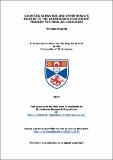Counting subwords and other results related to the generalised star-height problem for regular languages
Abstract
The Generalised Star-Height Problem is an open question in the field of formal language theory that concerns a measure of complexity on the class of regular languages; specifically, it asks whether or not there exists an algorithm to determine the generalised star-height of a given regular language. Rather surprisingly, it is not yet known whether there exists a regular language of generalised star-height greater than one.
Motivated by a theorem of Thérien, we first take a combinatorial approach to the problem and consider the languages in which every word features a fixed contiguous subword an exact number of times. We show that these languages are all of generalised star-height zero. Similarly, we consider the languages in which every word features a fixed contiguous subword a prescribed number of times modulo a fixed number and show that these languages are all of generalised star-height at most one.
Using these combinatorial results, we initiate work on identifying the generalised star-height of the languages that are recognised by finite semigroups. To do this, we establish the generalised star-height of languages recognised by Rees zero-matrix semigroups over nilpotent groups of classes zero and one before considering Rees zero-matrix semigroups over monogenic semigroups.
Finally, we explore the generalised star-height of languages recognised by finite groups of a given order. We do this through the use of finite state automata and 'count arrows' to examine semidirect products of the form 𝐴 ⋊ ℤ[sub]𝑟, where 𝐴 is an abelian group and ℤ[sub]𝑟 is the cyclic group of order 𝑟.
Type
Thesis, PhD Doctor of Philosophy
Collections
Items in the St Andrews Research Repository are protected by copyright, with all rights reserved, unless otherwise indicated.

